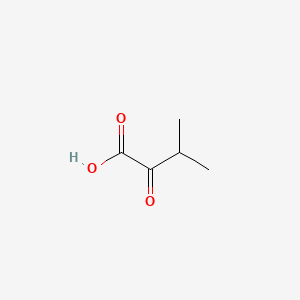| MeSH term | MeSH ID | Detail |
|---|---|---|
| Uremia | D014511 | 33 associated lipids |
| Kidney Failure, Chronic | D007676 | 51 associated lipids |
| Diabetes Mellitus | D003920 | 90 associated lipids |
| Ketosis | D007662 | 13 associated lipids |
| Body Weight | D001835 | 333 associated lipids |
| Carbon Tetrachloride Poisoning | D002252 | 12 associated lipids |
| Coronary Disease | D003327 | 70 associated lipids |
| Prostatic Neoplasms | D011471 | 126 associated lipids |
| Weight Gain | D015430 | 101 associated lipids |
| Glioma | D005910 | 112 associated lipids |
3-Methyl-2-oxobutanoic acid
3-Methyl-2-oxobutanoic acid is a lipid of Fatty Acyls (FA) class. 3-methyl-2-oxobutanoic acid is associated with abnormalities such as Maple Syrup Urine Disease and Kidney Failure, Chronic. The involved functions are known as Phosphorylation, Citric Acid Cycle, inhibitors, Process and Metabolic Control. 3-methyl-2-oxobutanoic acid often locates in Mitochondria, BL21, Cytoplasm, Ribosomes and Head. The associated genes with 3-Methyl-2-oxobutanoic acid are Genome, Homologous Gene, Operon, Alleles and Oxidoreductase Gene. The related lipids are dimyristoylphosphatidylglycerol, 9-oxononanoic acid, Valerates and alpha-ketocaproic acid.
Cross Reference
Introduction
To understand associated biological information of 3-Methyl-2-oxobutanoic acid, we collected biological information of abnormalities, associated pathways, cellular/molecular locations, biological functions, related genes/proteins, lipids and common seen animal/experimental models with organized paragraphs from literatures.
What diseases are associated with 3-Methyl-2-oxobutanoic acid?
3-Methyl-2-oxobutanoic acid is suspected in Maple Syrup Urine Disease, Kidney Failure, Chronic and other diseases in descending order of the highest number of associated sentences.
Related references are mostly published in these journals:
| Disease | Cross reference | Weighted score | Related literature |
|---|
Possible diseases from mapped MeSH terms on references
We collected disease MeSH terms mapped to the references associated with 3-Methyl-2-oxobutanoic acid
PubChem Associated disorders and diseases
What pathways are associated with 3-Methyl-2-oxobutanoic acid
There are no associated biomedical information in the current reference collection.
PubChem Biomolecular Interactions and Pathways
Link to PubChem Biomolecular Interactions and PathwaysWhat cellular locations are associated with 3-Methyl-2-oxobutanoic acid?
Visualization in cellular structure
Associated locations are in red color. Not associated locations are in black.
Related references are published most in these journals:
| Location | Cross reference | Weighted score | Related literatures |
|---|
What functions are associated with 3-Methyl-2-oxobutanoic acid?
Related references are published most in these journals:
| Function | Cross reference | Weighted score | Related literatures |
|---|
What lipids are associated with 3-Methyl-2-oxobutanoic acid?
Related references are published most in these journals:
| Lipid concept | Cross reference | Weighted score | Related literatures |
|---|
What genes are associated with 3-Methyl-2-oxobutanoic acid?
Related references are published most in these journals:
| Gene | Cross reference | Weighted score | Related literatures |
|---|
What common seen animal models are associated with 3-Methyl-2-oxobutanoic acid?
There are no associated biomedical information in the current reference collection.
NCBI Entrez Crosslinks
All references with 3-Methyl-2-oxobutanoic acid
Download all related citations| Authors | Title | Published | Journal | PubMed Link |
|---|---|---|---|---|
| Bückle-Vallant V et al. | Metabolic engineering of Corynebacterium glutamicum for 2-ketoisocaproate production. | 2014 | Appl. Microbiol. Biotechnol. | pmid:24169948 |
| Lang K et al. | Metabolic engineering of Pseudomonas sp. strain VLB120 as platform biocatalyst for the production of isobutyric acid and other secondary metabolites. | 2014 | Microb. Cell Fact. | pmid:24397404 |
| Panten U et al. | Acute metabolic amplification of insulin secretion in mouse islets is mediated by mitochondrial export of metabolites, but not by mitochondrial energy generation. | 2013 | Metab. Clin. Exp. | pmid:23790612 |
| Buchholz J et al. | Platform engineering of Corynebacterium glutamicum with reduced pyruvate dehydrogenase complex activity for improved production of L-lysine, L-valine, and 2-ketoisovalerate. | 2013 | Appl. Environ. Microbiol. | pmid:23835179 |
| Miyanoiri Y et al. | Differential isotope-labeling for Leu and Val residues in a protein by E. coli cellular expression using stereo-specifically methyl labeled amino acids. | 2013 | J. Biomol. NMR | pmid:24057411 |
| Boulangé CL et al. | Early metabolic adaptation in C57BL/6 mice resistant to high fat diet induced weight gain involves an activation of mitochondrial oxidative pathways. | 2013 | J. Proteome Res. | pmid:23473242 |
| Huisman FH et al. | Removal of the C-terminal regulatory domain of α-isopropylmalate synthase disrupts functional substrate binding. | 2012 | Biochemistry | pmid:22352945 |
| Beaudet AL | Neuroscience. Preventable forms of autism? | 2012 | Science | pmid:23087240 |
| Novarino G et al. | Mutations in BCKD-kinase lead to a potentially treatable form of autism with epilepsy. | 2012 | Science | pmid:22956686 |
| Zhang T et al. | Cloning and characterization of a novel 2-ketoisovalerate reductase from the beauvericin producer Fusarium proliferatum LF061. | 2012 | BMC Biotechnol. | pmid:22916830 |
